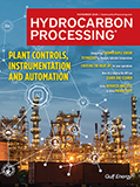Refining
ExxonMobil expands Beaumont refinery’s capacity to process light crudes
ExxonMobil will add flexibility to process light crudes at its Beaumont refinery, increasing production capacity by approximately 20,000 bpd, the company said.
REG to acquire US biodiesel refiner Imperium
REG will acquire all the assets of Imperium, including a 100-million gal capacity biomass-based diesel refinery and deepwater port terminal at the Port of Grays Harbor, Washington.
Consider Zone 0 vertical pumps for slop pits
Over the past several decades, a leading overseas HPI corporation experienced a disturbing number of explosions in its belowground hydrocarbon sump pits.
Wetted surface area calculations for fire-relief sizing in ASME pressure vessels
Although individual operating facilities take many steps to protect plants from fire, pressure vessels within a fire zone must be protected by a pressure safety valve (PSV). Proper calculation of the vessel’s wetted surface area is a crucial step in properly sizing a PSV.
HP Editorial Comment: An extraordinary year and new beginnings
It is quite extraordinary, the events that can happen within a single year. Beginning in July 2014, the world began to witness a widespread fall in crude oil prices. By the end of January 2015, both W..
HP Reliability: Ten sure steps to substandard reliability performance
Equipment reliability can be enhanced or jeopardized by many different actions, inactions, commissions and omissions. Reliability may be a hollow term to many. Still, first and foremost, a reliable plant is a safe plant.
HP Project Management: An update on Lang factors
Lang factors are cited frequently and used within the HPI. With the ensuing changes, the question must be asked, “Do Lang factors still present a realistic approximation of capital cost today?”
HP Petrochemicals: Consultant: Managers need long-term focus to find downstream sustainability
Top industry management should consider profits over the long term to make the business case for more sustainability, with a particular focus on results in the four-to-five-year range rather than on the initial year or two.
HP Refining: Peru: Modernization of the Talara refinery
The mega-project expansion at the Talara refinery is the foundation of Petroperu’s new strategic plan to increase refining capacity and reduce the sulfur content in refined products.
HP Viewpoint: Must devices be certified for use in safety instrumented systems?
For decades, process industries have used different forms of safety control based on what was available in the market. The simple answer to the question of whether SIS devices need to be certified is, "No," but operators and the industry as a whole continue to ask for certification anyway. Why is this?

- NAPCOR releases 2024 PET recycling report highlighting system efficiency gains and continued strength of PET circularity 12/12
- OQ courts other partners for petrochemical complex in Oman as SABIC drops out 12/12
- Brazil's BNDES approves $71 MM for carbon storage project 12/12
- Cuba on edge as U.S. seizure of oil tanker puts supply at risk 12/12
- China oil demand to plateau between 2025 and 2030 12/12
- Germany's PCK refinery says no impact from pipeline leak 12/12




